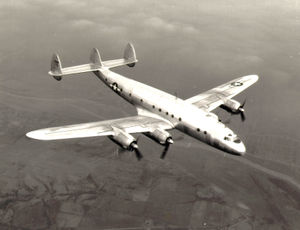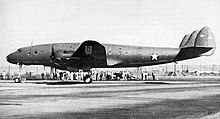Lockheed C-69 Constellation
| C-69 Constellation | |
|---|---|

| |
| A C-69 Constellation in flight | |
| Role | Transport |
| National origin | United States |
| Manufacturer | Lockheed |
| Designer | Kelly Johnson |
| First flight | January 9, 1943 |
| Introduction | July 28, 1943 |
| Retired | 1945 (except C-69C) |
| Status | Retired |
| Primary user | United States Army Air Forces |
| Produced | 1942–1945 |
| Number built | 22 |
| Variants | L-049 Constellation
|
The Lockheed C-69 Constellation was a four-engined, propeller-driven military transport aircraft developed during World War II. It was co-developed with the Lockheed Constellation airliner.
It first flew in 1943, and production of the 22 constructed was shared between the United States Army Air Forces (15) and commercial carriers. Most of the C-69 aircraft built were later converted into civilian airliners under the designation Lockheed L-049 Constellation.[1]
Design and development
Following the

Around the same time the decision regarding contract W535 AC-26610 was made, the prototype XC-69 was completed and rolled out in December 1942. The aircraft was painted in olive green and grey

On January 9, 1943, after the last inspections had been carried out by the USAAF and Lockheed, the XC-69 finally took to the skies. For the occasion, Lockheed had borrowed the
Major problems, however, surfaced with the R-3350 powerplant that powered the C-69, when an XB-29 test aircraft crashed into a Boeing factory. The accident killed 14 factory workers, Edmund Allen, and the rest of Allen's test crew. The cause was due to one of the aircraft's R-3350 engines catching fire and burning through the wing of the aircraft causing it to fail and dooming the XB-29. All aircraft fitted with the R-3350, including the C-69, were grounded until the investigation of the engine's failure was concluded. The conclusion led to a recommendation to replace the existing carburetors with more reliable ones. With that, testing resumed after June 18, 1943. A fuel leakage problem was discovered with the C-69 and wasn't solved until April 1944 when a new method of sealing the fuel tanks surfaced. More overheating, fire and other troubles continued with the R-3350 engines. This happened to the point where Lockheed started to doubt the abilities of the engine's manufacturer, Curtiss-Wright. Lockheed suggested to the USAAF that the C-69's engines be replaced by more reliable R-2800 radial engines. Instead, the USAAF ceased production of the R-3350 until the troubles that plagued the engines were solved. This caused the development of the C-69 to slow down and furthermore, the C-69 was not declared a priority. Lockheed continued to focus on building combat aircraft while the C-54 Skymaster, the C-69's competitor was already flying and officially ordered.
The second production C-69 had first flown in August 1943. Lockheed had hoped to produce four C-69 aircraft by the end of 1943, but due to the low importance of the C-69 to the USAAF, this didn't occur. On April 16, 1944,
Unfortunately for Lockheed, the C-69 became less important to the war effort as time progressed, especially since the tide of the war had turned in favor of the Allies. Only a small number of C-69 aircraft would see service in the last year of the war. Even so, Lockheed was able to conduct tests at the expense of the government to solve problems with the aircraft's design. Although the problems with the R-3350 were being solved, the B-29 had priority for the engines over the C-69. Even with all the effort put forth by Lockheed, the USAAF favored the C-54 Skymaster over the C-69. At the end of the war, only 22 C-69s were produced (seven of which were never delivered). Except for the C-69C, all other C-69s were declared surplus and sold on the civilian market between 1946 and 1947. These would later be converted by Lockheed into L-049 passenger aircraft for airline usage. The prototype XC-69 was converted into the sole XC-69E, which tested the possibility of using the R-2800 in place of the R-3350. This never happened. The XC-69E was later sold to the
Variants
| Variant | Built |
|---|---|
| XC-69 | 1 |
| C-69-1-LO | 16 |
| C-69-5-LO | 4 |
| C-69C-1-LO | 1 |
- XC-69
- Unpressurized prototype version. One built.
- C-69
- Initial troop transport version. 13 built. Seven others were under construction, but converted to L-049 airliners while still on the assembly line.
- C-69A
- Troop transport with a different internal layout than the C-69. None built
- C-69B
- Long range troop and cargo transport with a cargo door on the left. None built. Company designation L-349.
- C-69C
- VIP transport version based on the initial C-69. One built. Company designation L-549.
- C-69D
- VIP transport with different engines with extra oil and fuel tanks. None built.
- XC-69E
- Prototype XC-69 converted to use four R-3350for testing purposes.
Specifications (C-69)

Data from Lockheed Constellation:From Excalibur to Starliner[3] and Dave's Warbirds.com [4]
General characteristics
- Crew: 4
- Length: 95 ft 2 in (29.01 m)
- Wingspan: 123 ft (37 m)
- Height: 22 ft 5 in (6.83 m)
- Wing area: 1,650 sq ft (153 m2)
- Airfoil: root: NACA 23018; tip: NACA 4412[5]
- Empty weight: 50,000 lb (22,680 kg)
- Max takeoff weight: 72,000 lb (32,659 kg)
- Powerplant: 4 × Wright R-3350-35 Duplex-Cyclone18-cylinder air-cooled radial piston engines, 2,200 hp (1,600 kW) each
- Propellers: 3-bladed constant-speed propellers
Performance
- Maximum speed: 330 mph (530 km/h, 290 kn) at 10,000 ft (3,048 m)
- Cruise speed: 227 mph (365 km/h, 197 kn)
- Range: 2,400 mi (3,900 km, 2,100 nmi)
- Service ceiling: 25,030 ft (7,630 m)
See also
Related development
- Lockheed Constellation
- Lockheed L-049 Constellation
- Lockheed L-649 Constellation
- Lockheed L-749 Constellation
- Lockheed L-1049 Super Constellation
- Lockheed C-121/R7V Constellation
- Lockheed L-1249 Super Constellation (YC-121F/R7V-2)
- Lockheed EC-121 Warning Star
- Lockheed L-1649 Starliner
Aircraft of comparable role, configuration, and era
- Boeing B-29 Superfortress
- Boeing 377 Stratocruiser
- Bristol Britannia
- Douglas DC-4/C-54 Skymaster
- Douglas DC-6/C-118 Liftmaster
- Douglas DC-7
- Ilyushin Il-18
- Lockheed L-188 Electra
- Republic XF-12 Rainbow
- Vickers Viscount
Related lists
- List of Lockheed aircraft
- List of models of the Lockheed Constellation
- List of Lockheed Constellation operators
References
Notes
- ISBN 2-915239-62-2. p. 11 to p. 17.
- ^ Anorama – Lockheed Constellation – by Matthew Quiroz; Retrieved 10/8/11
- ^ Breffort, Dominique. Lockheed Constellation: from Excalibur to Starliner Civilian and Military Variants. Histoire and Collecions, 2006, p. 175.
- ^ Dave's Warbirds – C-69 Constellation Info; Retrieved 9/5/11
- ^ Lednicer, David. "The Incomplete Guide to Airfoil Usage". m-selig.ae.illinois.edu. Retrieved 16 April 2019.
Bibliography
- Breffort, Dominique (2006). "Lockheed Constellation: from Excalibur to Starliner Civilian and Military Variants". Histoire and Collecions. Paris: Print. ISBN 2-915239-62-2.
External links
- Lockheed Constellation Survivors – A website that explains information and whereabouts of surviving Constellations of all variants, including the last surviving C-69 Constellation.
